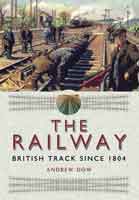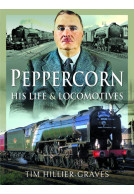Gloucester Locomotive Sheds: Horton Road & Barnwood (ePub)
Engine and Train Workings
Imprint: Pen & Sword Transport
File Size: 61.0 MB (.epub)
Pages: 229
Illustrations: 200
ISBN: 9781473875616
Published: 30th January 2019
GLOUCESTER LOCOMOTIVE SHEDS is the latest in a series of in-depth studies of motive power depots during the latter days of steam, looking closely at their changing engine allocations and operational responsibilities. At the time, Gloucester was a busy and fascinating rail centre where ex-GWR and ex-LMS (Midland Railway) routes met, each with main line passenger and freight services, local passenger trains and extensive freight trips providing an endless panorama of railway activity.
The principal ex-GWR Gloucester Horton Road and ex-LMS (Midland Railway) Gloucester Barnwood motive power depots are covered in depth with their locomotive allocations, operational duties and changing responsibilities over the years fully described. Not forgotten are both depots’ sub-sheds at Brimscombe, Cheltenham Malvern Road, Lydney, Ross-on-Wye, Dursley and Tewkesbury along with the duties and local routes that they covered.
This in-depth study is supported by over 200 well-chosen black and white photographs, many of which are previously unpublished, and each of the motive power depots covered are supported by detailed plans of the shed layouts.
This new book follows the same author’s successful “Hereford Locomotive Shed” published in October 2017 and further books are planned in the series.
This book is a complete dedication by this enthusiast to his subject. Only years of work can lead to a publication of this detail, of which includes much technical detail along with maps of the sheds and their uses. The period photographs are of particular interest as well as atmospheric. Another excellent work by this author, of which I would consider of extreme interest to the enthusiast.
Review by Andy Thomson
Reviewed alongside Hereford Locomotive Shed and Worcester Locomotive Shed
6024 Preservation Society
All in all, the three volumes are an outstanding album of photographs and historical memories which deserve a place on every Great Western Railway enthusiast's shelf.
As featured in
Spring/Summer 2020 edition of Penfriend
"It is a great and impressive read from start to finish."
Worcester Locomotive Society
This Pen & Sword volume is the second in the publisher’s series about steam sheds and their locos towards the end of the steam era. The GWR and LMS sheds at Gloucester are given in-depth photographic coverage in terms both of the depots themselves and the trains worked from them. Several pages of text describe the loco classes based at the sheds with reminiscences of loco crews and descriptions of workings. The reader is left with a good overview of operations in the area, helped by some good quality photographs which are sharply reproduced.
West Somerset Railway Association
Gloucester was an interesting railway centre during the steam era sitting on main line routes of both the Western and London Midland Regions. In the earliest days of railways many readers will recall that it was a place of some infamy because of the delays occasioned to both passengers and freight due to the change of gauge from the broad tracks of the Bristol and Gloucester Railway to the narrow ones of the Birmingham and Gloucester Railway.
Friends of the National Railway Museum
Such frustrations were ancient history by the period being written about here, but the city still had two main stations and two important locomotive depots - the Western’s Horton Road and the Midland’s Barnwood that form the centre-piece of this interesting and informative book. It is the second for author Steve Bartlett following on from his study of Hereford and its sheds. I had the pleasure of reviewing his earlier book and this is of a similar high quality in terms of both presentation and content.
The former Great Western Horton Road was the larger of the two Gloucester sheds with a varied allocation of locomotives covering an equally wide range of passenger and freight duties. Pride of place went to the Paddington jobs, including the Cheltenham Spa Express, for which a number of ‘Castle’ 4-6-0s were allocated. These switched to diesel haulage in November 1962, but Horton Road would eventually be host to the last ‘Castle’ in BR service, No 7029 Clun Castle, until withdrawn into preservation at the end of 1965. Gloucester had been an early candidate for single car rail motor trains on the Golden Valley route to Stroud and Chalford in the Edwardian period; later enhanced as one or two coach auto-trains (push-pull). Fittingly this service became one of the last such operations until withdrawal in October 1964, and a chapter is devoted to the working of these trains mainly by 14xx 0-4-2ts.
Lacking the glamour work of Horton Road, or volume of work, Barnwood shed was still a significant depot as a relief point for both engines and crews on the Midland’s important cross-country route from the North East to the South West. After this route was transferred to the Western Region in 1958 there was a gradual ‘Westernisation’ followed by a decline in work for Barnwood and the depot closed in May 1964 thereafter being used for a time to store withdrawn locomotives awaiting their fate with the scrap merchant (I recall seeing no lesser engine than Windsor Castle here in late 1964).
In the late fifties there were a total of six sub-sheds coming under the two main Gloucester depots. Some such as Cheltenham Malvern Road, which had a staff establishment of over eighty and seven allocated locomotives as late as 1961, were substantial affairs in their own right. Another, Lydney, serving a network of branch lines in the Forest of Dean coalfield, still had an allocation of fourteen locos in 1960.
Two chapters for each of the Gloucester depots cover respectively ‘shed layouts and staffing’, and ‘locomotive allocations and duties’ in the years running up to the demise of steam. There are also chapters covering the pattern of passenger and train services in the Gloucester district and separate chapters for each of the sub-sheds. The book is liberally illustrated throughout with a comprehensive selection of photographs accompanied by track diagrams and tables giving shed allocations at various dates. These should be particularly useful to modellers.
The author not only knew the area well in the period covered by the book, but had a father who held a senior motive power position at the time. He then went on to have a long and distinguished career in railway operations himself. This combination of knowledge and experience has been well used, together with access to some invaluable records covering not just locomotive allocations, but train workings and diagrams.
This is another well-presented Pen & Sword book of which both the author and publisher can be proud. I have no hesitation in recommending it for anyone interested in locomotive matters in the last decade of steam.
Although possibly of less interest to GW enthusiasts, the Midland sub-sheds at Dursley and Twkesbury are equally fascinating, providing glimpses of Nailsworth, Stroud and Upton-on-Severn. Lovely.
Great Western Echo
Featured by
British Railway Modelling, May 2019
As featured by
Friends Of Swindon Railway Museum
This book comprises an excellent and comprehensive reference work on the railways around Gloucester, and brings back many happy memories to your reviewer. It is highly recommended to anyone who knows the area, and also to anyone who wants to expand their knowledge of the district.
Bradford Railway Circle
At 230 pages, Steve Bartlett's latest offering from Pen & Sword is a book that offers a combination of facts and opinions about the structures and train workings in and around the Gloucester area.
Manchester Locomotive Society
As with most MPD's, at times and on the last minute, things were prone to change, challenge or go wrong. This is what makes reading this, such a good journey for the rail enthusiast.
Review Of The Month
Steam World, May 2019
This is a captivating glimpse of a way of life that we couldn't have imagined would be gone so quickly and is warmly recommended.
A fascinating insight into an important railway location.
Steam Days magazine, April 2019 - reviewed by Roger Smith
Full of iconic and nostalgic photographs of a place about three miles down the road from where I lived for the first fifteen years of my life.
Books Monthly
Read the full review here
Being a Gloucester lad in the 1950s and '60s this book is especially poignant to me. Saying that, I thoroughly enjoyed it, although the inclusion of colour photos would have been an extra bonus. I am pretty sure that the trainspotter in the photo on page 9 is me, but if not, then this was a favourite spot for me as I lived only a short distance from Eastgate station. Also it was good to see so many images from my friend John Goss included in the book. On my way to the Crypt School in the late '50s and early '60s I used to see the up 'Cheltenham Spa Express' every morning hauled by a well-polished 'Castle' Class loco hauling its train of chocolate and cream coaches - 'Spitfire' and 'Winchester Castle' were regular performers then. On my way home from school I also used to see 'The Devonian' on its way north from Bristol usually hauled by a 'Jubilee' locomotive. I even travelled on the last auto train service from Gloucester to Chalford on 31 October 1964. Churchdown station was my favourite spot for trainspotting on summer Saturdays as many of the trains packed with holidaymakers usually took the Gloucester avoiding line (as many of the Bristol to Birmingham trains today take, thus avoiding a stop at a city with a population of 129,000). Gloucester during that period was a wonderful place to live for a young railway enthusiast. All that is a dim and distant recollection but this book brought the memories flooding back. Well done Steve Bartlett! Check me out on Instagram for other railway memories of that period: julianhollandrailways
Julian Holland
A comprehensively detailed historical study, "Gloucester Locomotive Sheds: Horton Road & Barnwood" is an impressively informed and informative volume that is wholeheartedly recommended for both community and academic library British Railroading History collections and supplemental studies lists.
Midwest Book Review
Read the full review here
About Steve Bartlett
Steve Bartlett is a fourth generation railwayman, with railways in his blood.
His father was Swindon Works trained, becoming a Western Region District Running & Maintenance Officer, his grandfather also worked at Swindon Works in Great Western days and his great grandfather was a station master at Staverton in Devon for twenty five years from 1898 to 1923.
As a young teenager the author recorded the last days of Western Region steam, before joining the railway in 1966.
He then spent almost forty years working in rail operations and managing timetable planning, locomotive and train crew diagramming before finally working on West Coast Route Modernisation.He now researches and writes about the latter days of steam, mainly on the former Great Western, specialising in locomotive depots, their allocations and operational duties.
He lives in Nantwich in Cheshire and is married with two grown up sons and five grandchildren.
















